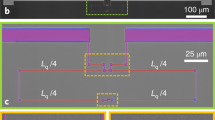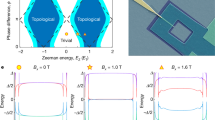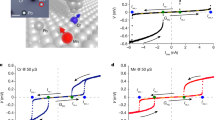Abstract
Mesoscopic Josephson junctions, consisting of overlapping superconducting electrodes separated by a nanometre-thin oxide layer, provide a precious source of nonlinearity for superconducting quantum circuits. Here we show that in a fluxonium qubit, the role of the Josephson junction can also be played by a lithographically defined, self-structured granular aluminium nanojunction: a superconductor–insulator–superconductor Josephson junction obtained in a single-layer, zero-angle evaporation. The measured spectrum of the resulting qubit, which we nickname gralmonium, is indistinguishable from that of a standard fluxonium. Remarkably, the lack of a mesoscopic parallel plate capacitor gives rise to an intrinsically large granular aluminium nanojunction charging energy in the range of tens of gigahertz, comparable to its Josephson energy. We measure coherence times in the microsecond range and we observe spontaneous jumps of the value of the Josephson energy on timescales from milliseconds to days, which offers a powerful diagnostics tool for microscopic defects in superconducting materials.
This is a preview of subscription content, access via your institution
Access options
Access Nature and 54 other Nature Portfolio journals
Get Nature+, our best-value online-access subscription
$29.99 / 30 days
cancel any time
Subscribe to this journal
Receive 12 print issues and online access
$259.00 per year
only $21.58 per issue
Buy this article
- Purchase on Springer Link
- Instant access to full article PDF
Prices may be subject to local taxes which are calculated during checkout



Similar content being viewed by others
Data availability
All relevant data are available from the corresponding authors upon reasonable request.
References
Nakamura, Y., Pashkin, Y. A. & Tsai, J. S. Coherent control of macroscopic quantum states in a single-Cooper-pair box. Nature 398, 786–788 (1999).
Koch, J. et al. Charge-insensitive qubit design derived from the Cooper pair box. Phys. Rev. A 76, 042319 (2007).
Manucharyan, V. E., Koch, J., Glazman, L. I. & Devoret, M. H. Fluxonium: single Cooper pair circuit free of charge offsets. Science 326, 113–116 (2009).
Gu, X., Kockum, A. F., Miranowicz, A., Liu, Y.-x. & Nori, F. Microwave photonics with superconducting quantum circuits. Phys. Rep. 718–719, 1–102 (2017).
Blais, A., Grimsmo, A. L., Girvin, S. M. & Wallraff, A. Circuit quantum electrodynamics. Rev. Mod. Phys. 93, 025005 (2021).
Kandala, A. et al. Error mitigation extends the computational reach of a noisy quantum processor. Nature 567, 491–495 (2019).
Gold, A. et al. Entanglement across separate silicon dies in a modular superconducting qubit device. npj Quantum Inf. 7, 142 (2021).
Bao, F. et al. Fluxonium: an alternative qubit platform for high-fidelity operations. Phys. Rev. Lett. 129, 010502 (2022).
McEwen, M. et al. Resolving catastrophic error bursts from cosmic rays in large arrays of superconducting qubits. Nat. Phys. 18, 107–111 (2022).
Josephson, B. Possible new effects in superconductive tunnelling. Phys. Lett. 1, 251–253 (1962).
Kreikebaum, J. M., O’Brien, K. P., Morvan, A. & Siddiqi, I. Improving wafer-scale Josephson junction resistance variation in superconducting quantum coherent circuits. Supercond. Sci. Technol. 33, 06LT02 (2020).
Paik, H. et al. Observation of high coherence in Josephson junction qubits measured in a three-dimensional circuit QED architecture. Phys. Rev. Lett. 107, 240501 (2011).
Somoroff, A. et al. Millisecond coherence in a superconducting qubit. Preprint at https://arxiv.org/abs/2103.08578 (2021).
Siddiqi, I. Engineering high-coherence superconducting qubits. Nat. Rev. Mater. 6, 875–891 (2021).
Krause, J. et al. Magnetic field resilience of three-dimensional transmons with thin-film Al/AlOx/Al Josephson junctions approaching 1 T. Phys. Rev. Appl. 17, 034032 (2022).
Clerk, A. A., Lehnert, K. W., Bertet, P., Petta, J. R. & Nakamura, Y. Hybrid quantum systems with circuit quantum electrodynamics. Nat. Phys. 16, 257–267 (2020).
Kurizki, G. et al. Quantum technologies with hybrid systems. Proc. Natl Acad. Sci. USA 112, 3866–3873 (2015).
Groszkowski, P. et al. Coherence properties of the 0-π qubit. New J. Phys. 20, 043053 (2018).
Peruzzo, M. et al. Geometric superinductance qubits: controlling phase delocalization across a single Josephson junction. PRX Quantum 2, 040341 (2021).
Janvier, C. et al. Coherent manipulation of Andreev states in superconducting atomic contacts. Science 349, 1199–1202 (2015).
Hays, M. et al. Coherent manipulation of an Andreev spin qubit. Science 373, 430–433 (2021).
Pita-Vidal, M. et al. Gate-tunable field-compatible fluxonium. Phys. Rev. Appl. 14, 064038 (2020).
Tinkham, M. in Introduction to Superconductivity Ch. 6.1 (Dover Publications, 2004).
Golubov, A. A., Kupriyanov, M. Y. & Il’ichev, E. The current-phase relation in Josephson junctions. Rev. Mod. Phys. 76, 411–469 (2004).
Lam, S. K. H. Noise properties of SQUIDs made from nanobridges. Supercond. Sci. Technol. 19, 963–967 (2006).
Astafiev, O. V. et al. Coherent quantum phase slip. Nature 484, 355–358 (2012).
Peltonen, J. T. et al. Coherent dynamics and decoherence in a superconducting weak link. Phys. Rev. B 94, 180508 (2016).
Grünhaupt, L. et al. Granular aluminium as a superconducting material for high-impedance quantum circuits. Nat. Mater. 18, 816–819 (2019).
Zhang, H. et al. Universal fast-flux control of a coherent, low-frequency qubit. Phys. Rev. X 11, 011010 (2021).
Deutscher, G., Fenichel, H., Gershenson, M., Grünbaum, E. & Ovadyahu, Z. Transition to zero dimensionality in granular aluminum superconducting films. J. Low Temp. Phys. 10, 231–243 (1973).
Glezer Moshe, A., Farber, E. & Deutscher, G. Granular superconductors for high kinetic inductance and low loss quantum devices. Appl. Phys. Lett. 117, 062601 (2020).
Borisov, K. et al. Superconducting granular aluminum resonators resilient to magnetic fields up to 1 tesla. Appl. Phys. Lett. 117, 120502 (2020).
Kou, A. et al. Simultaneous monitoring of fluxonium qubits in a waveguide. Phys. Rev. Appl. 9, 064022 (2018).
Cohen, R. W. & Abeles, B. Superconductivity in granular aluminum films. Phys. Rev. 168, 444–450 (1968).
Voss, J. N. et al. Eliminating quantum phase slips in superconducting nanowires. ACS Nano 15, 4108–4114 (2021).
Maleeva, N. et al. Circuit quantum electrodynamics of granular aluminum resonators. Nat. Commun. 9, 3889 (2018).
Levy-Bertrand, F. et al. Electrodynamics of granular aluminum from superconductor to insulator: observation of collective superconducting modes. Phys. Rev. B 99, 094506 (2019).
Winkel, P. et al. Nondegenerate parametric amplifiers based on dispersion-engineered Josephson-junction arrays. Phys. Rev. Appl. 13, 024015 (2020).
Smith, W. C. et al. Quantization of inductively shunted superconducting circuits. Phys. Rev. B 94, 144507 (2016).
Friedrich, F. et al. Onset of phase diffusion in high kinetic inductance granular aluminum micro-SQUIDs. Supercond. Sci. Technol. 32, 125008 (2019).
Winkel, P. et al. Implementation of a transmon qubit using superconducting granular aluminum. Phys. Rev. X 10, 031032 (2020).
Gusenkova, D. et al. Quantum nondemolition dispersive readout of a superconducting artificial atom using large photon numbers. Phys. Rev. Appl. 15, 064030 (2021).
Rastelli, G., Pop, I. M. & Hekking, F. W. J. Quantum phase slips in Josephson junction rings. Phys. Rev. B 87, 174513 (2013).
Eckern, U., Schön, G. & Ambegaokar, V. Quantum dynamics of a superconducting tunnel junction. Phys. Rev. B 30, 6419–6431 (1984).
Pop, I. M. et al. Experimental demonstration of Aharonov-Casher interference in a Josephson junction circuit. Phys. Rev. B 85, 094503 (2012).
Lisenfeld, J. et al. Electric field spectroscopy of material defects in transmon qubits. npj Quantum Inf. 5, 105 (2019).
Hertzberg, J. B. et al. Laser-annealing Josephson junctions for yielding scaled-up superconducting quantum processors. npjQuantum Inf. 7, 129 (2021).
Frattini, N. E. et al. 3-wave mixing Josephson dipole element. Appl. Phys. Lett. 110, 222603 (2017).
Beloborodov, I. S., Lopatin, A. V., Vinokur, V. M. & Efetov, K. B. Granular electronic systems. Rev. Mod. Phys. 79, 469–518 (2007).
Sacépé, B., Feigel’man, M. & Klapwijk, T. M. Quantum breakdown of superconductivity in low-dimensional materials. Nat. Phys. 16, 734–746 (2020).
Acknowledgements
We are grateful to U. Vool for fruitful discussions, and we acknowledge technical support from S. Diewald, A. Eberhardt, M. K. Gamer, A. Lukashenko and L. Radtke. Funding is provided by the Alexander von Humboldt Foundation in the framework of a Sofja Kovalevskaja award endowed by the German Federal Ministry of Education and Research and by the European Union’s Horizon 2020 programme under grant no. 899561 (AVaQus). P.P. and I.M.P. acknowledge support from the German Ministry of Education and Research within the QUANTERA project SiUCs (FKZ, 13N15209). D.R., S.G., P.W. and W.W. acknowledge support from the European Research Council advanced grant MoQuOS (no. 741276). Facility use was supported by the Karlsruhe Nano Micro Facility and KIT Nanostructure Service Laboratory. We acknowledge qKit for providing a convenient measurement software framework.
Author information
Authors and Affiliations
Contributions
D.R., S.G., M.S. and I.M.P. conceived and designed the experiment. D.R. and S.G. performed the microwave simulation. P.P., L.H., J.K.H. and A.B. contributed to the device fabrication. D.R., S.G., M.S. and P.W. participated in the measurements. D.R. and S.G. analysed the data. D.R. and S.G. led the paper writing, and M.S., P.P., P.W., J.K.H., W.W. and I.M.P. contributed to the text. W.W. and I.M.P. supervised the project.
Corresponding authors
Ethics declarations
Competing interests
The authors declare no competing interests.
Peer review
Peer review information
Nature Materials thanks Ivan Pechenezhskiy and the other, anonymous, reviewer(s) for their contribution to the peer review of this work.
Additional information
Publisher’s note Springer Nature remains neutral with regard to jurisdictional claims in published maps and institutional affiliations.
Supplementary information
Supplementary Information
Supplementary Figs. 1–13 and Discussion.
Rights and permissions
Springer Nature or its licensor (e.g. a society or other partner) holds exclusive rights to this article under a publishing agreement with the author(s) or other rightsholder(s); author self-archiving of the accepted manuscript version of this article is solely governed by the terms of such publishing agreement and applicable law.
About this article
Cite this article
Rieger, D., Günzler, S., Spiecker, M. et al. Granular aluminium nanojunction fluxonium qubit. Nat. Mater. 22, 194–199 (2023). https://doi.org/10.1038/s41563-022-01417-9
Received:
Accepted:
Published:
Issue Date:
DOI: https://doi.org/10.1038/s41563-022-01417-9
This article is cited by
-
Steps towards current metrology
Nature Physics (2023)



